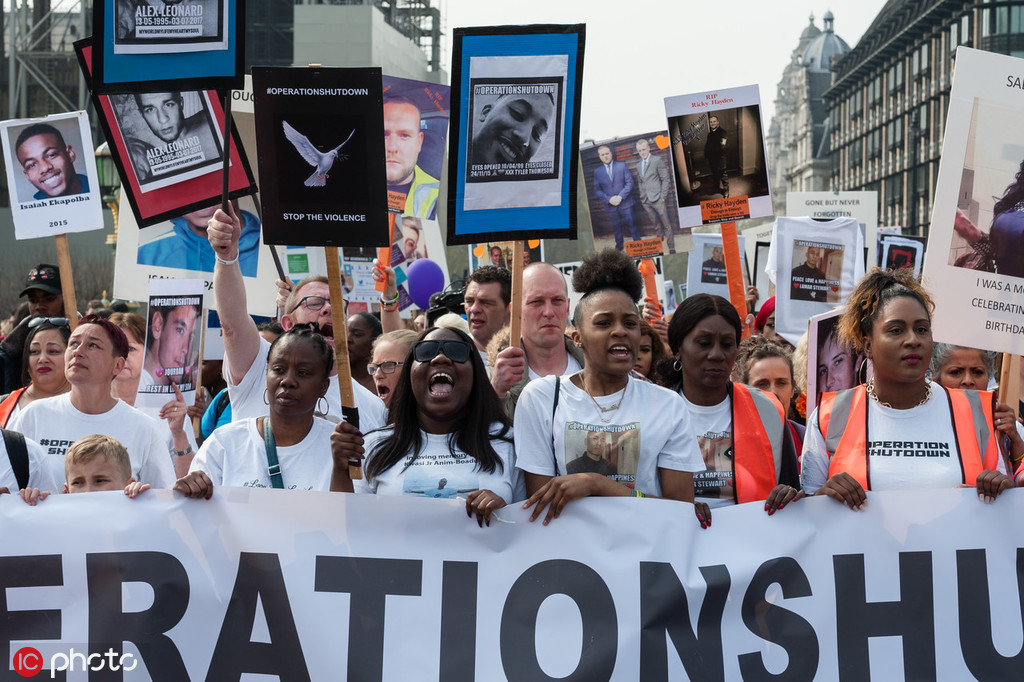UK struggles against knife crime epidemic
By BO LEUNG | China Daily Global | Updated: 2019-04-30 09:14

Survey reveals numerous causes behind alarming increase in violent offences
Officials and policymakers must look into the underlying causes of knife crime, and beyond legal crackdowns, if they are to tackle the problem, according to academics who were commenting on the latest statistics that show knife crime in England and Wales is at record levels.
According to the Office for National Statistics, also known as the ONS, the United Kingdom's largest independent producer of official statistics, there was a 6 percent increase in the number of police-recorded offenses involving knives or sharp instruments in 2018.
In the year to December 2018, the number of homicides also increased by 6 percent, with 732 lives lost. The previous year's total was 690.
The homicide total includes murders and deaths resulting from manslaughter, corporate manslaughter, and infanticide.
In 2018, offenses involving knives rose to 40,829. That number excludes incidents recorded by the Greater Manchester police force, which are absent from the report because of a technical issue. It is the largest number recorded by the ONS, since 2011.
The knife crimes recorded included 19,000 assaults, 17,400 robberies, 464 rapes, 149 sexual assaults, and 252 homicides.
The ONS said knife crimes tend to be concentrated in urban areas. Last year, 33 percent of all knife offenses were committed in London, where there was a rate of 167 offenses per 100,000 people.
Britain's knife crime epidemic has made headlines in recent months because of a spate of assaults and killings involving young people. The youngest stabbing victim in London so far this year was 14 years old.
According to the statistics, 31 of the 43 police forces taking part recorded a growth in knife offenses in 2018.
Adam Lynes, a senior lecturer in criminology at Birmingham City University, believes the rise in knife crime is due to the ripple effect of years of austerity and recession.
Lynes said some people in the 15-to-18 age group, who grew up during periods of economic uncertainty, are now in a situation where there seem to be few legitimate routes to opportunity.
According to admissions data for National Health Service hospitals in England, there were 4,986 reported admissions connected to assaults involving a sharp object between April 2017 and March 2018, an increase of 15 percent compared to the previous period.
"This increase in violent crime is a continuing, worrying trend," said Thom Brooks, a professor of law and government and a dean at Durham Law School. "An important factor, without a doubt, is cuts made to police numbers. There are fewer police to investigate crimes with too many left unchecked. A product of the government's austerity program, it's time that the cuts were reversed now that the chancellor has claimed austerity is over. Unfortunately, for the public, these words have not been followed by action."
According to a Home Office report, the number of police officers in England and Wales has fallen since 2009 by more than 21,000.
The ONS also recorded a 12 percent rise in the number of frauds, an 11 percent increase in robberies, and an 8 percent jump in the number of thefts.
While firearms offences fell by 2 percent, to 6,525, the ONS said the drop was in contrast to recent years during which there has been a trend of a growing number of such offenses.
Alexa Bradley, from the ONS's center for crime and justice, said: "It is important to look at each crime type separately because the picture is very mixed.
"Even within crime types, we have seen differences. Robbery and vehicle offenses have increased, whereas burglary has decreased. Lower-volume high-harm violence involving knives has risen, whereas offences involving firearms have decreased."
Lynes pointed out that, in addition to the fall in the number of police officers, a lack of public spending, budget cuts, and the closure of community centers have also been factors in the increase in reported crime. He said more should be done within communities to engage young people.
"It's about putting money in the right places," Lynes said. "Locking up people in some instances won't work … it's targeting people who are already disenfranchised. They probably think they don't have much to lose. That won't work as a deterrent at all."
He said there is a need to look deeper into the root causes of knife and violent crime and to examine why some young people think they do not have alternatives.
"For a long time, we ignored what's underneath and just see what's at the tip of the iceberg, and that's someone getting stabbed, and we don't really dig beneath the surface and look at all the various factors that ultimately led to this direct violent act," Lynes said, adding that there should be more investment in community-based policing to improve relations between law enforcement and young people.
The criminologist said that government plans to give the police more powers to stop and search suspects will not solve the problem because they will only fuel resentment and animosity toward the authorities.
The police power to stop and search people has been controversial for many years and critics have said police officers have used it to target some ethnic minority groups.
In a bid to tackle knife crime in London, the capital's mayor, Sadiq Khan, launched a knife crime strategy to target lawbreakers, work with young people and communities, and support victims.
In March, Prime Minister Theresa May came under fire after rejecting claims that cuts to police forces contributed to the rising number of knife attacks. She insisted there was "no direct correlation" between the two.
Following the prime minister's comments, Cressida Dick, commissioner of the Metropolitan Police Service, said there is "some link" between police numbers and violent crime.
























